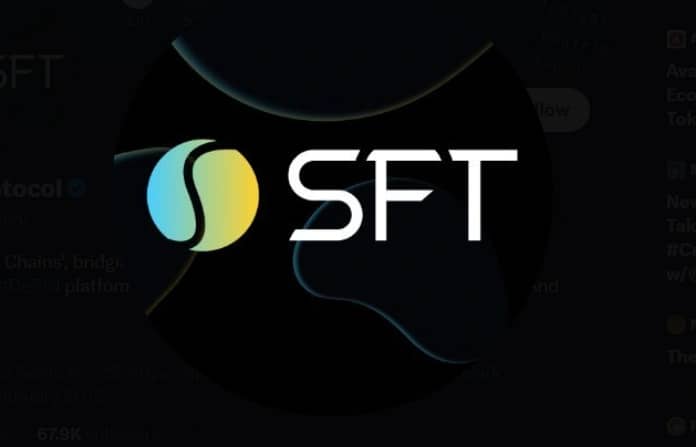위키 구독하기
Share wiki
Bookmark
SFT Protocol
SFT Protocol
SFT 프로토콜은 물리적 인프라와 Web3 기술을 연결하여 포괄적인 분산형 물리적 인프라 네트워크(DePIN)를 구축하도록 설계된 분산형 플랫폼입니다. 다양한 하드웨어 및 데이터 서비스를 단일 분산형 자율 조직(DAO)으로 통합하여 신흥 기술에서 증가하는 컴퓨팅 리소스 수요에 대응하는 것을 목표로 합니다. [1][3][5]
개요
SFT 프로토콜은 다양한 블록체인 네트워크의 코인을 사용하는 거래를 위한 시장 역할을 하는 "체인 오브 체인(Chain of Chains)" 개념을 기반으로 구축되었습니다. 주요 목표는 다양한 하드웨어 및 데이터 서비스를 통합하기 위한 지속 가능하고 유연한 프레임워크를 만드는 것입니다. 이 프로토콜은 지속적이고 유기적인 성장을 보장하고 이해 관계자와 DAO에 수익을 제공하기 위해 경매 시스템을 활용합니다. [2]
SFT 프로토콜은 스테이킹 자산에 대한 유동성을 제공하고 고성능 퍼블릭 체인 클라우드 노드를 구축하기 위한 분산형 프로토콜입니다. 개인 정보 보호 컴퓨팅 및 분산 스토리지 기능을 제공하는 것 외에도 플랫폼 제공자 역할도 합니다. [5]
SFT 프로토콜의 주요 기능은 다음과 같습니다.
- 장기간 잠긴 자산을 위한 Liquid 스테이킹 파생 상품
- 통합된 체인의 래핑된 코인
- 전체-노드 RPC 서비스
- 분산형 스토리지, 대역폭 및 컴퓨팅
- AI 컴퓨팅 서비스
- GPU 렌더링(공용 및 개인)
- IoT 및 기타 소스로부터 암호화되고 검증 가능한 데이터 수집
체인 오브 체인
"체인 오브 체인" 개념은 서로 다른 블록체인 네트워크에서 다양한 코인으로 거래하는 시장 역할을 하는 분산 네트워크를 의미합니다. 유기적인 성장을 촉진하고 다양한 하드웨어 유형을 통합하며 수익 안정성을 유지하기 위해 경매 시스템을 사용합니다. [2]
초기에는 유동성 스테이킹 파생 상품과 수익 창출에 중점을 두고 있으며, 스토리지 및 RPC와 같은 온체인 서비스와 AI 컴퓨팅과 같은 오프체인 서비스로 확장할 계획입니다. 목표는 지속 가능한 분산형 글로벌 투자 및 인프라 플랫폼을 만드는 것입니다. [2]
DePIN
SFT 체인과 그것이 구축하는 DePIN 네트워크는 Web2 기반 기업의 전통을 깨고 조직 및 커뮤니티 개발자가 Web3 기반 애플리케이션을 구축하여 SFT 체인 장치의 다양성을 달성하고 블록체인 기반 소유권 관리 및 오프체인 SFT 체인 데이터 처리 및 스토리지 등을 가능하게 하는 것을 목표로 합니다. [2]
핵심 구성 요소
DAO 스마트 계약
DAO는 프로토콜의 관리 기구 역할을 하며, 재무부를 소유하고 수익을 받고, 새로운 프로젝트, 파트너, 통합 및 수익 배분에 대한 투표를 하고, DAO 토큰 보유자를 위한 스테이킹/거버넌스 메커니즘을 담당합니다. [4]
유동성 스테이킹 파생 상품 및 래핑된 코인
이 프로토콜은 통합된 스테이킹 네트워크(예: Filecoin의 경우 SFT)에 대한 LSD 토큰과 다른 블록체인(예: Bitcoin)의 래핑된 토큰을 지원합니다. [4]
유동성 채권 경매
하드웨어 수익의 일부는 유동성 제공자 (LP) 토큰과 교환하여 경매됩니다. 이 메커니즘은 프로토콜의 건전한 유기적 성장과 LSD, 래핑된 토큰 및 DAO 토큰 기능의 원활한 작동을 보장합니다. [4]
분산형 하드웨어 소유권
이 프로토콜은 하드웨어 소유권에 대한 세 가지 모델을 통합합니다.
- 직접 모델: 기존 데이터 센터에 공동으로 배치된 장비에 대한 서비스 제공자 계약을 사용합니다.
- 분산 모델: 파트너 서비스 및 네트워크를 통합합니다.
- 분산 모델: 자체 레이어 1 블록체인에 있는 DAO 소유 노드[4]
제품
스테이킹
스테이크 계약 섹션은 FEVM 및 BSC 네트워크에 구축되어 있으며, 고정 기간 팜 및 유동성 풀 예치에 대한 진입점을 제공하고 온체인 및 섹션별 수익 데이터를 표시합니다. 고정 기간 팜 진입을 선택하면 사용자는 FIL 예치, SFT 미팅 및 고정 기간 예치를 한 번에 완료하여 FIL과 rSPD 보상을 얻을 수 있습니다. 유동성 풀 진입(FEVM 전용)을 선택하면 사용자는 FIL을 예치하고 rSFT를 즉시 지갑으로 미팅하여 유동성 풀 보상을 얻을 수 있습니다. [10]
팜
SFT 팜은 암호화폐 보유자가 다른 사용자와 자금을 모아 투자 수익을 추구할 수 있는 시스템입니다. SFT 고정 예치, Stake Raydium-LP, Stake rSFT, Stake LP 및 Stake Sushi-LP와 같은 제품을 제공합니다. 사용자는 프로토콜을 통해 토큰 인증서를 스테이킹하여 수익을 얻을 수 있습니다. [11]
풀
풀 계약 모듈은 FEVM 네트워크에 구축되어 있으며, "플라이휠" 경제 시스템 내에서 다양한 기능을 수행합니다. 사용자는 SFT 팜을 지원하기 위해 FIL을 빌리고, 고정 기간 팜 상환을 위한 브리지 자금을 제공하고, 유동성 풀에 FIL을 기여하여 보상을 얻고, LP 스테이킹으로 생성된 수익을 풀에 예치할 수 있습니다. [12]
DePIN
DePIN 섹션은 Solana 및 FEVM 네트워크에 구축된 초기 단계 테스트넷 퍼블릭 체인 프로젝트를 통합하는 것을 목표로 합니다. 투자자는 rSPD를 사용하여 참여하고, 메인넷 출시 시 추가 보상을 받습니다. 참여에 사용된 모든 rSPD는 소각됩니다. [13]
브리지
이 분산형 크로스체인 브리지는 SFT, rSPD 등의 토큰을 Solana, FEVM 및 BSC 네트워크의 대상 주소로 전송하는 것을 용이하게 합니다. 크로스체인 거래 중에는 5 rSPD의 수수료가 부과되며, 이 수수료는 전액 소각됩니다. [14]
팀
잘못된 내용이 있나요?
